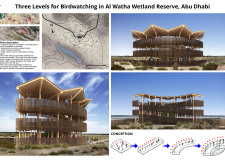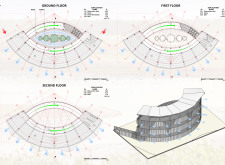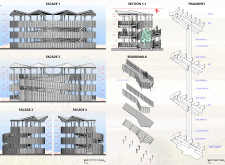5 key facts about this project
This facility represents a commitment to sustainable design principles, emphasizing an approach that respects and enhances the surrounding wetland environment. The primary function of the architecture is to facilitate birdwatching, yet it serves a broader purpose by fostering a connection between visitors and the natural world. By providing various levels for observation, the project optimizes visitor experiences, offering different vantage points to appreciate the rich avian life in the wetlands.
Key design elements of the birdwatching facility include its three distinct observation levels. Each level is thoughtfully integrated into the landscape, allowing visitors to engage with the environment in varying capacities. The ground floor features a wet garden, providing opportunities for visitors to immerse themselves in local flora. The first floor includes educational displays that enhance understanding and appreciation of the wetland ecosystem, while the second floor serves primarily as an elevated observation platform, offering expansive views across the landscape.
A unique aspect of this design is its radial layout, which strategically channels visitor flow and optimizes lines of sight toward the wetland. The curvature of the building not only contributes to aesthetic appeal but also ensures that the facility remains unobtrusive in its natural setting. This organic form is complemented by the careful selection of materials, such as concrete for structural integrity, sustainable wood for framing, and reed for roofing. These materials not only provide durability but also promote harmony with the surrounding environment.
The architecture incorporates ramps that facilitate accessibility, encouraging exploration and interaction across all levels. This inclusive design approach reflects a commitment to ensuring that all visitors can experience and appreciate the building and its natural context. Furthermore, the careful consideration of natural light and ventilation throughout ensures a comfortable environment, enhancing the overall visitor experience.
The project’s emphasis on minimal environmental impact is evident in its construction methods, which prioritize sustainability and local craftsmanship. The facility uses materials that are well-suited to the local climate and environment, fostering a sense of place and contributing to the ecological integrity of the site.
Overall, this birdwatching facility serves as a model of architecture that respects nature while providing meaningful spaces for human interaction. With its thoughtful design choices, sustainable material use, and commitment to enhancing biodiversity education, this project stands as a relevant contribution to the architectural landscape of Abu Dhabi. For those interested in exploring the intricacies of this design further, reviewing architectural plans, sections, and detailed designs will provide deeper insights into the innovative approaches taken throughout the project.


























